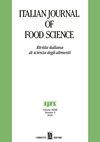Wine recommendation algorithm based on partitioning and stacking integration strategy for Chinese wine consumers
IF 3.3
4区 农林科学
Q2 FOOD SCIENCE & TECHNOLOGY
引用次数: 0
Abstract
This study tries to propose a wine recommendation algorithm based on partitioning and Stacking Integration Strategy for Chinese wine consumers. The approaches follow the idea of partitioning, decomposing traditional recommendation task into several subtasks according to wine attributes, using neural network, support vector machine (SVM), decision tree, random forest, optimized random forest, Adaboost and XGBoost as recommendation models. Then, based on Stacking integration method, five models are screened out for each recommendation index as the base classifier, and the decision tree or logistic regression model is selected as the meta-learner to construct a two-layer Stacking integration framework. Finally, the optimal recommendation algorithm be built for recommendation subtasks according to the prediction accuracy. The result showed that the Stacking integrated recommendation model was suitable for the recommendation of eight attributes including colour, sweetness, foamability, mouthfeel, aroma type, year, packaging and brand, while SVM model was suitable to recommend aroma concentration and price, and the XGboost model was most appropriate for origin. This study would subserve consumers to choose the wine more easily and conveniently and provide support for wine companies to improve customer satisfaction with consumer services. The study expands the approach of concerning research and proposes a specific multi-model recommendation strategy based on artificial intelligence models to recommend multiattribute commodities.基于划分和堆叠集成策略的中国葡萄酒消费者推荐算法
本研究试图针对中国葡萄酒消费者提出一种基于划分与堆叠整合策略的葡萄酒推荐算法。该方法遵循划分思想,将传统推荐任务根据葡萄酒属性分解为若干子任务,采用神经网络、支持向量机(SVM)、决策树、随机森林、优化随机森林、Adaboost和XGBoost作为推荐模型。然后,基于Stacking集成方法,为每个推荐指标筛选出5个模型作为基分类器,选择决策树或逻辑回归模型作为元学习器,构建两层Stacking集成框架。最后,根据预测精度构建推荐子任务的最优推荐算法。结果表明,Stacking综合推荐模型适合推荐颜色、甜度、起泡度、口感、香气类型、年份、包装、品牌等8个属性,SVM模型适合推荐香气浓度和价格,XGboost模型最适合推荐产地。本研究将使消费者更容易、更方便地选择葡萄酒,并为葡萄酒企业提高消费者服务满意度提供支持。本研究扩展了相关研究的方法,提出了一种基于人工智能模型的多模型推荐策略,用于多属性商品的推荐。
本文章由计算机程序翻译,如有差异,请以英文原文为准。
求助全文
约1分钟内获得全文
求助全文
来源期刊

Italian Journal of Food Science
工程技术-食品科技
CiteScore
4.20
自引率
0.00%
发文量
33
审稿时长
>36 weeks
期刊介绍:
"Italian Journal of Food Science" is an international journal publishing original, basic and applied papers, reviews, short communications, surveys and opinions on food science and technology with specific reference to the Mediterranean Region. Its expanded scope includes food production, food engineering, food management, food quality, shelf-life, consumer acceptance of foodstuffs, food safety and nutrition, energy and environmental aspects of food processing on the whole life cycle.
Reviews and surveys on specific topics relevant to the advance of the Mediterranean food industry are particularly welcome.
 求助内容:
求助内容: 应助结果提醒方式:
应助结果提醒方式:


